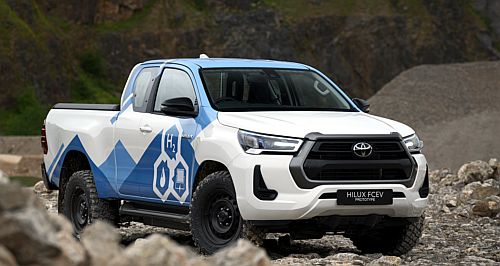News - Toyota - Hilux - FCEVHydrogen HiLux reaches final test phaseFinal testing phase for hydrogen fuel cell HiLux with real-world trials underway18 Jun 2024 TOYOTA has announced that its hydrogen fuel cell HiLux project in the UK has reached the final “demonstration phase”, with ten vehicles now undergoing field testing and customer engagement.
While Toyota was slow to move with battery electric vehicles (BEV), the brand has been a strong hybrid performer – with seven of the top 10 best-selling hybrids in Australia wearing the T badge in 2023 – and now it continues its push into the hydrogen space.
Toyota Australia told GoAuto it would welcome a hydrogen HiLux if there was an opportunity to evaluate it locally, but at this stage nothing is locked in.
“The HiLux FCEV is a Toyota UK-led trial,” a Toyota Australia spokesperson said.
“If a prototype were to become available for evaluation in Australia, we would welcome the opportunity, especially given the extensive involvement with HiLux by our vehicle evaluation department.”
The HiLux project kicked off with a feasibility study in early 2022, with Toyota using a representative prototype vehicle to demonstrate the advantages of hydrogen as an alternative fuel source.
Following the study, Toyota undertook design and development until January 2023, alongside consortium partners Ricardo, ETL, D2H Advanced Technologies and Thatcham Research.
A dedicated area of Toyota’s UK facility was used for parts manufacturing before the first prototype was built in just three weeks using a mix of manufactured parts and core elements from the Toyota Mirai sedan that has been available globally since 2015 as one of the world’s first mass-produced hydrogen fuel cell vehicles. A few dozen are leased in Australia.
The first HiLux prototype was unveiled in September last year and since then Toyota and its partners, with support from the British government, have been busy evaluating a small fleet of the vehicles.
According to Toyota, the fuel cell 4x2 extra-cab HiLux retains the same dimensions as its ICE equivalent, but offers an emission-free driving range of 600km.
In terms of layout, three high-pressure fuel tanks – each containing 2.6kg of hydrogen – are mounted within the ladder-frame chassis, a fuel cell stack is positioned above the front axle, and a lithium-ion battery is in the rear load deck. A rear e-axle then sends 134kW/300Nm to the wheels.
A total of 10 fuel cell HiLux prototypes have now been built at the Toyota Manufacturing UK facility in Derby, with five used for rigorous field testing and the other five assigned for customer and media demonstrations.
Toyota says two will be used at the Paris Olympic and Paralympic Games in July. It will also be using ten hydrogen fuel cell buses, converted alongside its CaetanoBus partner, to transport visitors during the games.
What will become of the hydrogen fuel cell HiLux prototypes and whether a production model is on the cards once the final stage of testing is complete is yet to be revealed.
Late last year, Toyota launched a similar program to test a fleet of seven HiAce Commuter H2 models, which would use Australia as a test bed for real-world fleet use. Unlike the fuel cell HiLux, the HiAce models used internal combustion engines that run on hydrogen.
“For commercial vehicles, Australia is seen as an ideal place to develop these vehicles to then be suitable for the rest of the world,” Toyota Australia senior manager of vehicle evaluations and regulations, Ray Munday said at the time.
“We have tested this car in the centre of Australia, and we have tested it in other areas as well. It has very flexible usage – because we are using the existing internal combustion engine technology, there are fewer blind spots of new technology (to overcome).
“Again, there are pluses and minuses to every technology, but (H2-ICE) has the advantage of (being able to operate under) high load and in a very wide set of environmental conditions.”
Toyota’s second-generation Mirai sedan, available in limited numbers for business and fleet customers Down Under, is proof the manufacturer’s hydrogen fuel-cell technology works. In fact, it offers a range of up to 650km putting it ahead of most electric only models.
Limited refuelling infrastructure remains an issue; Toyota owns just one hydrogen refuelling station in Victoria, and there are currently only 12 others operating or under construction in Australia.
Last year, Toyota Australia, Hyundai Motor Company Australia, Pacific Energy and Ampol signed a memorandum of understanding to co-develop a hydrogen refuelling network in the ACT.
The goal of the MOU was to combine knowledge and resources to develop hydrogen refuelling stations for H2-ICE and H2 FCEV vehicles around the territory, in a bid to solve the infrastructure puzzle.
“Infrastructure is still our biggest challenge, but we do still see it as a part of the future,” Toyota Australia vice president of sales and marketing, Sean Hanley said, when discussing the MOU.
“Infrastructure is not part of what we see as our future, but we may have to lead that to get the ball rolling while we’re transitioning to this technology and bringing volume to market.
“Hydrogen is still part of the future. I do believe it’s still in that 2030 to 2035 horizon, I think it’s a while to go, but certainly a technology we will continue to invest in and partner in.”  Read more6th of June 2024  Toyota LandCruiser Prado to remain dieselNo hybrid option for Prado; Toyota managing diesel wait lists, V8 LandCruiser 70 Series orders |
Click to shareToyota articlesResearch Toyota Hilux pricing
Motor industry news |
















Facebook Twitter Instagram